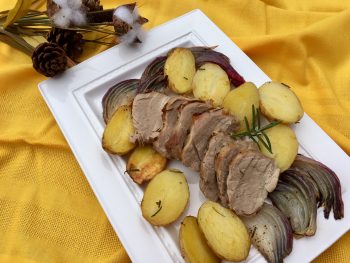By Cathy Branciaroli, Food Correspondent, The Times

Photo Caption: Brining pork tenderloins in apple cider and spices yields a moist, juicy and flavorful result.
Think apples are “As American as Apple Pie”? Think again. Apples as we know them today were not native to North America. When early colonists arrived from Europe, they disdained the tiny crab apples they found here and brought cuttings and seeds from their homelands in order to savor treasured orchard apples in the New World.
Here in the midst of National Apple Month and following on the heels of Johnny Appleseed’s birthday we should be grateful to those colonists even though it turns out that they cultivated apples primarily to make cider because it was safer to drink than water and easier to produce than beer.
Today only about 100 apple varieties are grown commercially in the United States, according to Lena Dati of North Star Orchards in Cochranville, Chester County. But in their orchards they cultivate more than 300 different types of heritage or antique types. Right now, late season varieties such as Golden Russet, which is sweet with an aroma of tangerine and possibly the oldest variety in the US, will be available into late November.
All varieties are suited for their tasks, Dati said, whether it’s providing that satisfying crispy crunch when eating fresh out of hand or lending sweetness to a baked dessert such as apple cake, her personal favorite. So how to choose when market baskets brimming with so many types and varieties are so enticing? It depends on what you are making, not to mention the flavor and texture of the apple.
To aid in selecting, here is a short guide from the American Apple Association for types and uses.
Braeburn. Medium crisp, sweet tart. Best used for pie, baking whole or chunky sauces
Cortland. Large, tender, resists browning. Best used for chunky sauces.
Empire. Crist, juicy, sweet-tart, fragrant. All purpose apple.
Fuji. Medium, firm, cream-color flesh, tangy, sweet. Best eaten raw.
Gala. Medium, firm, juicy sweet. Best eaten raw or in salads.
Golden Delicious. Medium, firm, sweet, fragrant. Best in pie or chunky sauces.
Granny Smith. Medium, crunchy, tart, juicy. Best for pie or baking.
Honey Crisp. Medium, sweet, firm. Many uses including pies and eating raw.
McIntosh. Medium, tender, fragrant. Best for smooth sauces like applesauce.
Jonagold. Large, crisp sweet-tart, fragrant. Best for pies and baking.
Pink Lady. Medium, creamy flesh, juicy, sweet. Best for pie.
Rome Beauty. Large, firm mildly-tart, juicy. Best for baking whole.
Lucky for me, I wasn’t forced to choose. Using apple cider in a brine prior to roasting my pork tenderloins insured a mix of varieties would contribute to my comfy and hearty fall dinner. Pork in general benefits from brining and the cider brine worked magic, imparting sweetness, juiciness and tons of flavor, which was heightened by drizzling the meat with a pan sauce for serving. Roasted Yukon Gold potatoes, Red Onions and Granny Smith apples rounded out the meal.
The best part? Other than the time for brining, this was a fast and nearly effortless meal to prepare.
North Star’s farm store is open Thursday – Sunday at 3232 Limestone Rd, Cochranville, PA 19330. Check their website for farm store hours: https://northstarorchard.com/
Cider-Brined Pork Loin with Roasted Potatoes and Apples
Ingredients for the Brine:
2 cups apple cider
½ cup granulated sugar
3 tbs salt
3 cloves garlic, chopped
1 tsp ground black pepper
1 tsp fennel seed
½ tsp ground coriander
1 inch fresh ginger, thinly sliced
Ingredients for the Pork and Pan-Sauce:
2 – 1 to 1½ lb pork tenderloins (this should be sold in one package)
1½ lb small Yukon Gold potatoes, halved
1-2 large red onions (about 1 lb) cut into 1 inch wedges
2-3 Granny Smith apples, unpeeled and cut into 2-3 inch wedges
3 tbs olive oil
2 tbs unsalted butter
1-2 tbs roughly chopped fresh rosemary
2 cups apple cider for sauce
Preparation:
For Marinade: In a small bowl, stir together the cider, sugar and salt till sugar dissolves. Add remaining seasonings till combined. Place the tenderloins into a 1 gallon ziplock bag, pour in the marinade, squeeze out the air, seal and refrigerate for 6-8 hours or overnight.
For the roast: Preheat oven to 425 degrees. Remove the tenderloins from the bag, discard the marinade, pat dry the loins, and using kitchen twine, tie the loin in three places at even intervals. Place prepared tenderloins on an ungreased rimmed baking pan. Dab with olive oil, season with 1 tsp pepper and a sprinkling of the rosemary, reserving about half for the vegetables.
For the vegetables: Using another baking pan, place the prepared vegetables in a single layer, drizzle with olive oil and season with 1 tsp salt, pepper and remaining rosemary.
Roasting: Place both baking pans in the oven on a middle rack, side by side. Roast for 30 minutes then check the vegetables for doneness and remove when browned and crisp. Continue to roast the pork till browned and a meat thermometer inserted into the center reads 140 degrees. Total cooking time on the meat will be 30-40 minutes. Remove the tenderloins from oven and the tray. Let rest on a platter.
For the pan sauce: Using a spatula, remove the juice and any meat particles to a saucepan and cook over medium stove heat with the butter and 1 tbs of olive oil. Cook, stirring often and scraping up any brown bits till simmering. Add 2 cups of cider and bring to boil, stirring constantly. Reduce heat and continue stirring till thickened, about 3-5 minutes, then season with salt and pepper.
To serve: Remove the twine from the meat. Slice the tenderloins diagonally into ½ inch pieces. Sprinkle with salt. Serve on a platter with the apples, potatoes and onion and top with the sauce.
Cathy Branciaroli also writes about her adventures in the kitchen on her award-winning blog Delaware Girl Eats







